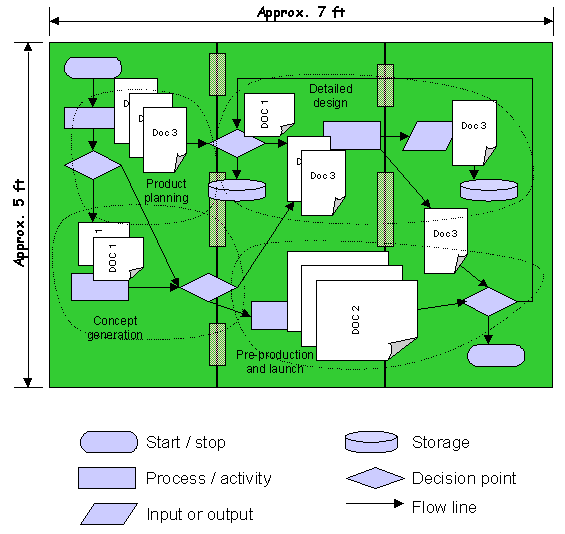Process mapping (brown paper)
A 'brown paper' exercise, is so called as it uses a large scale format to map an existing business process, with an emphasis on being 'rough and ready' rather than a precise, neat and tidy document. Applied to the product development process, it encourages a shared understanding of the implications of new product introduction on different parts of the business and helps to generate a shared ownership of the process. It is likely that the process map will illustrate the complexity of the NPI process and demonstrate critical flows of information, key check points and areas of over (or under) bureaucracy. The output is intentionally physically large, which can be daunting at first but aims to bring the process to life (see illustration).

Approach
Preparation - layout 'brown paper' and collect documents
The process map should be produced on a large piece of paper, about 7ft x 5ft). Brown paper is often used due to cost and availability, but any available paper stock is fine. Where necessary, join several pieces of paper which should be large enough to hold the project documentation and enable the process to be drawn in sufficient detail.
Collect together representative samples of the documentation as used at all stages of the NPI process. It is best to find and copy real examples, from real projects. Documents of interest include those which communicate information or record information. These might include purchase order, drawings, project plans, timesheets, parts lists etc. Equally important are documents which form part of the management and control cycle of a project. These might include authorisation sheets, plans, justifications, market reports, progress reports etc.
Arrange documents on paper
Arrange the documents on the paper to demonstrate the overall flow of the process. It helps to start at the top left aiming to finish at the bottom right hand corner. Start by just placing the documents on the brown paper and move them around to fit as the overall story becomes clearer.
Draw process
Using the documents as a guideline, draw the process, working from left to right and top to bottom. Wherever possible, use standard flow chart symbols, to depict: start and stop points; specific processes and activities; inputs/outputs to/from activities; decision points - Y/N/Maybe; document storage. It should be possible to run through the process and follow the flow of decisions and information.
Map the phases of the NPI process
Map the key project phases, with a dotted line around activities, documents and decision points within that phase. If no phases are currently defined, them using the process map as a guide, define some process stages. Make sure that all phases are represented, from idea to production implementation.
Critique process
Having produced the process map, the real benefit comes from critiquing the existing process. Using post-it™ notes, record any areas of uncertainty, difficulty or general interest (using different coloured post-it notes for different issues). The team should view this stage as an open brainstorm, where anything goes. Of particular interest are:
- How effective is the overall process structure?
- How effectively are the management and control elements defined, including decision points, reporting and authorisation?
- How are project risks managed?
- Who is involved when, how are projects resourced and managed?
- Is there effective leadership and does the organisation support teamwork?
- What information and communication is provided to different parts of the business?
- Are any metrics used to manage efficiency and effectiveness of execution?
- Where and when are external design specialists involved?
- Where, when and how often is there any customer or user input into a project?
Record actions & note possible improvements
The critique should generate some specific actions for further consideration and also possible ideas for process improvement. These should be recorded.
Re-engineer
Taking into account the issues raised during the critique session, re-engineer and simplify the process.
For more information, please contact:
T: +44 1223 764830









